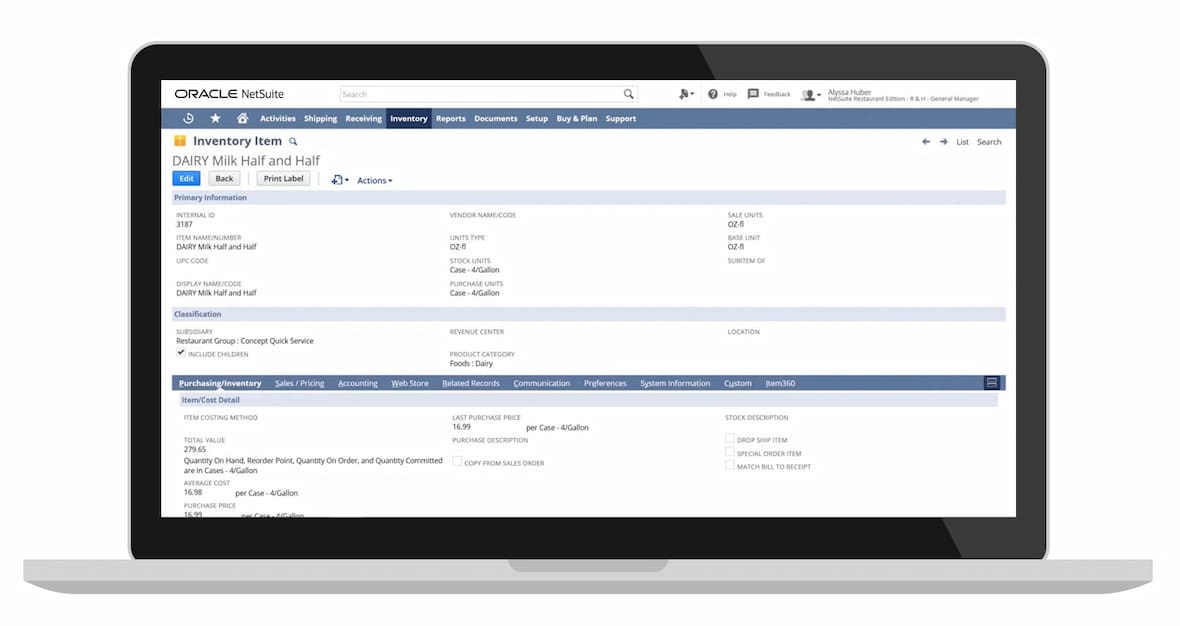Restaurants are finding new ways to cut down on food waste, a persistent source of frustration in the business. Digital advances in demand forecasting, inventory management and waste tracking are assuming a pivotal role alongside innovations in menu planning, recycling and composting. The stakes are high, both for restaurant profitability and for environmental responsibility. This article lists 21 actionable tips for reducing food waste in restaurants.
What Is Restaurant Food Waste?
Restaurant food waste refers to any edible food that is discarded by a dining establishment. It takes many forms, from spoilage in storage to scraps in the kitchen to leftover food on diners’ plates. A 2024 article in the New York Times concluded that restaurants waste 5% to 15% of the food they buy.
Restaurant food waste hurts business in more ways than one. Not only does it directly drain restaurant profits, but it can also increase disposal costs, draw the ire of regulators, contribute to greenhouse gas emissions in landfills and undermine efforts to develop an environmentally and socially responsible brand identity.
Key Takeaways
- Restaurants are combating food waste with innovative strategies and technologies.
- Reducing waste is good for business and good for the environment.
- Digitizing demand forecasting, inventory management and other tasks can help restaurants reduce waste.
Restaurant Food Waste Explained
Of course, some food waste is inevitable in day-to-day restaurant operations. Food is perishable, after all. In storage, despite best efforts, some items will unavoidably spoil due to unexpected changes in demand. In the kitchen, preparation often leaves peels and other trimmings. In the dining room, customers with quixotic appetites can leave lots of food on the plate.
To minimize losses like these, a survey by a kitchen equipment company found that 93% of restaurants have implemented waste reduction initiatives or are in the process of doing so. The top three initiatives, according to the survey, are conducting employee training and awareness, keeping waste logs and deploying inventory management systems.
Types of Food Waste at Restaurants
Food waste is so great in the United States that the White House unveiled a national strategy in mid-2024 to cut it in half by 2030. Over half of America’s wasted food comes from restaurants and other businesses in the food industry, according to Feeding America. And as if that weren’t wasteful enough, in addition to food waste, restaurants also need to cut down on excess energy and water use, discarded packaging, operational inefficiencies and other types of waste. Here are eight types of food and other waste:
- Pre-consumer waste: Various types of pre-consumer waste can cost restaurants money. For instance, preparation waste includes trimmings, peels and other byproducts generated during food preparation, such as eggshells, banana peels, spent coffee grounds and excess fat or gristle. Spoilage waste results from food items that expire or go bad before they are used, which can happen due to over-ordering, improper storage or inadequate inventory management. Overproduction waste occurs when too much food is prepared and cannot be sold or repurposed.
- Post-consumer waste: Many diners leave large amounts of food on their plates. This “plate waste” often results from large portion sizes, unappealing presentation or food that does not meet customers’ tastes. Compounding the issue, customers often take home leftovers but then do not consume them, eventually leading to waste.
- Operational waste: This refers to food waste stemming from the regular activities of running a restaurant, such as inventory management and menu planning. Inventory waste may arise from poor inventory management practices, culminating in expired or spoiled stock that cannot be used. Menu flops linked to unpopular or seasonal menu items that do not sell well could result in unused ingredients. Equipment malfunctions, such as refrigeration failure, can also cause significant food spoilage.
- Packaging waste: Packaging waste includes items such as to-go boxes, delivery containers, disposable cups and utensils that are single-use, non-compostable or otherwise wasteful. Excessive use of these items not only contributes to environmental pollution but also increases the restaurant’s waste disposal costs and carbon footprint.
- Unavoidable waste: Unavoidable waste is a type of waste that restaurants cannot completely eliminate, even with the most efficient practices in place. This includes waste from labor, such as staff time that may be underutilized during slow periods; energy waste from the necessary heating and lighting of the restaurant; and waste resulting from the wear and tear of kitchen equipment and dining room furniture, which will eventually need to be replaced.
- Special event waste: This type of waste primarily stems from catering and buffet-style events, where excess food is prepared but not consumed. Special event waste often results from overestimating guest attendance or misjudging preferences.
- Miscommunication waste: Food waste can result from incorrect orders, either due to kitchen mistakes, errors on the part of waitstaff or customer misunderstandings.
- Excessive trimming waste: Though some trimming waste is inevitable, it can occur in excess when usable parts of ingredients are discarded during food preparation. The culprit might be improper knife skills, over-preparation or inefficient use of ingredients, but this kind of excessive waste can be handled through better training and awareness.
The Impact of Restaurant Food Waste
Restaurant food waste imposes environmental, economic and social costs on the business and the community it serves. Reducing such costs can help curb greenhouse gasses, save businesses money and build cleaner, healthier communities, the White House noted in its national food waste reduction strategy. Here’s a breakdown of the impacts of restaurant food waste.
Environmental Consequences
Only about one-third of restaurants surveyed by Datassential, a food service management consultant, said their operations were sustainable, but seven out of 10 said improving on this circumstance was a top priority. Some establishments have already gone the distance, such as a self-proclaimed “zero waste, carbon neutral” wine bar and food purveyor in Brooklyn, N.Y. Environmental impacts include:
- Greenhouse gas emissions: All the resources that go into growing, transporting, storing and preparing food generate greenhouse gas emissions, meaning that any food waste actually has a larger environmental impact than meets the eye.
- Landfill usage: Food and packaging that decomposes in landfills produces methane, which is worse than carbon dioxide for global warming. The increasing prevalence of take-out food has also contributed to unsustainable levels of microplastics in landfills, soil and water, which have only recently begun to be addressed by regulation and company policies advancing eco-friendly food packaging options.
Economic Implications
It’s notoriously difficult to run a profitable restaurant, with a typical establishment registering a pretax profit margin of about 5%, according to the National Restaurant Association (NRA). Food and beverage costs account for nearly a quarter of overall expenses, so food waste certainly doesn’t help restaurants succeed.
- Lost revenue: Revenue is hard-earned in the restaurant business, and food costs are historically high. Every ingredient that ends up in the trash when it shouldn’t represents money that could have contributed to the restaurant’s profitability.
- Increased disposal costs: As waste volumes rise, so do the expenses associated with collection, hauling and landfill tipping fees. Restaurants can face fines if their waste is not properly sorted or if they exceed certain waste thresholds.
Social Impact
Restaurant food waste also has significant social implications that extend beyond the business itself. At a macro level, it highlights social inequities in a country where one in eight households experienced food insecurity in 2022, according to the Food Research and Action Center. At the micro level, it can attract pests and create other unsanitary conditions in the community.
- Food insecurity: As millions of people struggle with hunger, the food wasted in restaurants could instead help feed those in need. Donating surplus food to local charities and food banks can make a meaningful difference in communities.
- Corporate social responsibility (CSR): Consumers and employees increasingly expect businesses to operate sustainably and ethically. Restaurants that work to reduce food waste demonstrate their commitment to CSR, which can enhance their reputation and the loyalty of customers and staff.
- Regulatory compliance: Many state and local governments and regulatory bodies are implementing stricter waste management policies. In a typical example, Arizona legislation requires some restaurants to offer reusable take-out containers as an option, bans Styrofoam and prohibits restaurants from automatically providing plastic straws with drinks. Restaurants that fail to comply with these regulations may face license suspension, fines and lawsuits. Some local municipalities regulate the recycling of cooking oils.
Benefits of Reducing Food Waste in Restaurants
Restaurants and other food service businesses produced 13 million tons of surplus food in 2022, according to ReFED, a national nonprofit focused on solving food waste. Of this surplus, more than 85% went to a landfill or incinerator and less than 1% was donated. An effective waste reduction strategy can deliver a range of operational, financial and reputational benefits.
- Cost savings: Waste reduction measures, such as inventory management, portion control and the repurposing of ingredients, can help save costs.
- Improved profit margins: The cost of food waste can erode profit margins, which few restaurants can afford when nearly 40% didn’t turn a profit in 2023, according to the NRA.
- Enhanced efficiency: Waste is the antithesis of efficiency, whereas waste reduction initiatives tend to deliver operational savings by streamlining back-of-house operations while sparing ingredients from the trash heap.
- Improved customer satisfaction: Nearly half of consumers surveyed by PwC management consultants said they are choosing to spend more sustainably, and 78% of those polled by Datassential said they think restaurants can do more to reduce waste.
- Employee engagement: A survey by the Deloitte management consultancy shows employee recruitment, retention and morale to be top benefits of sustainability initiatives, such as waste reduction.
- Regulatory compliance: Proactively reducing food waste helps restaurants stay ahead of evolving regulations as they become more stringent.
- Brand image and loyalty: Nearly 80% of Americans prefer dining at certified green restaurants, according to the Green Restaurant Association.
21 Tips to Reduce Restaurant Food Waste
Tackling food waste in restaurants requires a combination of strategic planning, innovative thinking and practical implementation. From harnessing technology to fostering a waste-conscious culture among staff, there are many ways restaurants can shrink their food waste footprint. The following 21 tips provide a road map to reducing food waste in restaurants.
-
Forecast Accurately
Use data-driven tools to predict demand and adjust inventory accordingly. By leveraging data on historical sales performance, weather patterns and major events in the vicinity, restaurants can create better forecasts to optimize ordering, keep just the right amount of ingredients in inventory to avoid spoilage, and prevent stockouts. For example, using data from point of sale (POS) systems, staff can run a time series analysis of how sales have fluctuated over time due to seasonal or other cyclical trends.
-
Check Inventory Regularly
Focus on inventory management, which includes tallying and analyzing food waste to avoid future losses. And when reordering is automated within inventory management systems, it enables the replenishment of more appropriate amounts of ingredients, helping to avoid spoilage. For example, some POS systems feature “suggested ordering” to optimize replenishment of stock levels based on real-time sales.
-
Design Flexible Menus
Create menus that allow for a single ingredient, such as chicken, to be used across multiple menu items. For example, chicken breasts can be used for salad, thighs for a stir-fry and bones saved for stock. Additional flexibility comes from providing guests with choices of meal size and contents (for instance, a half or full salad with or without salmon, chicken or shrimp).
-
Use Daily Specials
Offer specials to use up surplus ingredients and reduce waste. Daily specials provide an opportunity to showcase creativity while minimizing food waste. For example, cooking up wilting greens in a pot with a leftover ham bone and cheap, shelf-stable beans delivers a respectable soup du jour.
-
Implement the FIFO Method
Follow the “first in, first out” inventory principle, aka FIFO, to ensure that older ingredients are used before others. In other words, prioritize the products that were ordered and received first and use them before the rest. Given the perishability of food, this proactive approach not only cuts down on waste but also helps maintain optimal quality and freshness.
-
Prepare Efficiently
Use precise measurements and portion control to minimize excess food preparation. Investing in proper measuring tools, such as digital scales, portion scoops and pour spouts, and training staff to use them routinely can significantly reduce over-preparation waste. Other tips include using standardized recipes; creating detailed prep sheets for each shift, based on expected demand; and having a process for labeling excess items that can be repurposed for future use, such as too many cut onions.
-
Repurpose Scraps Creatively
Upcycle scraps and trimmings to reduce waste and even impart new depth to dishes. That is, instead of discarding a ham bone or the leaves from a celery stalk, add them to a soup. Datassential found that one in five restaurants today feature dishes that include upcycled ingredients. One steak restaurant in California goes as far as to buy whole cows from a local supplier and uses every part of the animal to reduce waste and food costs. For example, steaks are browned in clarified fat scraps, which are also melted into beef tallow for use in pastries and breads — all at a fraction of the cost of butter.
-
Audit Waste Regularly
Conduct waste audits to identify sources of food waste and areas for improvement. By carefully examining discarded food items, restaurants can pinpoint problem areas like overproduction, improper storage or inaccurate portion sizes. These insights provide valuable data on which to formulate strategies for reducing waste and improving overall kitchen efficiency. A monthly audit should allow for timely identification and correction of any issues uncovered, though some argue that the ideal frequency for auditing waste is daily, aided by waste tracking apps, such as those described below in No. 10. Separate waste into categories, such as plate waste left by diners, kitchen preparation waste and expired food. Some of the estimates might be made visually, while others may rely on sensors in the stockroom that monitor perishable food, for example, among other techniques and tools. The audit then becomes the foundation for an action plan.
-
Collect Data
Automate data collection on food waste to provide up-to-date information, reduce data entry mistakes and free up staff time for other tasks. Keep in mind that updated data means that restaurants can identify waste patterns quickly, allowing for prompt adjustments to ordering, production and menu planning. Although using scales, measuring cups, spreadsheets and other manual tools can gain restaurants some traction in collecting data on food waste, more modern methods are becoming more affordable and accessible even for smaller restaurants.
-
Leverage Waste-Tracking Apps
Track food waste using these digital tools, and use the data collected to inform better decisions on purchasing inventory, planning menus and deciding portion sizes. Higher food costs in 2023 drove 37% of restaurants to increase the tracking of their food waste, according to the NRA. In one academic study, hotels with self-service breakfast buffets were able to reduce leftovers by nearly 4,000 pounds per kitchen per year. Some of the tools map inventory levels to consumption patterns in order to identify losses; others use specially designed bins with sensors to weigh waste. In more advanced apps, built-in cameras with artificial intelligence features can sit above trash cans, capture food waste images, identify them, estimate their weight and value and deliver the findings graphically to the chef.
-
Use Inventory Management Software
Use an inventory management system to streamline ordering, monitor supplies on hand, reduce overstock and prevent stockouts. Bonus points for integrating the system with POS terminals to calculate waste (e.g., calculating ingredients purchased vs. menu items sold). Quick access to such data makes it easier to identify high-waste items and improve menu engineering.
Sample restaurant inventory item dashboard. -
Educate Staff
Institute training to discourage kitchen staff from over-preparing food or improperly storing ingredients while promoting the use of food scraps and trimmings. Training employees in food waste reduction techniques and best practices can not only empower staff with the knowledge and skills to minimize waste, but will also foster a culture of sustainability within the restaurant.
-
Offer Incentives
Consider bonuses — such as gift cards or extra time off — for meeting or exceeding waste reduction goals. Or even without monetary rewards, publicly acknowledging employees’ contributions, through company newsletters, staff meetings or social media, can boost morale and create a culture of sustainability.
-
Communicate Efforts
Promote any sustainability initiatives, such as waste reduction, on menus and signage, as well as in social media and through waitstaff’s interactions with diners. Doing so can attract environmentally conscious diners and enhance the restaurant’s reputation. Likewise, employees today favor working with socially and environmentally responsible companies. Given the rapid turnover in the restaurant industry, communicating sustainability efforts can help find and retain like-minded staff.
-
Collect Feedback
Seek input from customers and staff to identify areas for improvement. For one thing, by understanding customer preferences regarding portion sizes and menu items, restaurants can adjust offerings accordingly. For another, staff insights into kitchen operations, ingredient usage and waste patterns can reveal areas for improvement in ordering, storage and food preparation.
-
Compost Scraps
Implement a composting program to divert food waste from landfills and contribute to a more sustainable environment. Some specialized businesses collect and transport restaurant food waste to composting facilities, while others sell equipment, such as aerators for on-site composting. Training on proper composting techniques and guidance on complying with regulations is also available.
-
Recycle Materials
Use recyclable or compostable packaging for take-out orders and leftover containers. And make sure that kitchen and waitstaff properly dispose of recyclables as well, by providing clear signage, separate bins and employee training. Make some extra money by selling (instead of trashing) used equipment, for which there’s a dynamic market.
-
Partner With Suppliers
Choose suppliers with solid sustainability policies and procedures, and collaborate with them to minimize food and packaging waste in the supply chain. Collaborative efforts between restaurants and suppliers can identify opportunities to improve production, transportation and distribution, which will ultimately decrease the overall environmental impact.
-
Donate Surplus Food
Partner with local food pantries and other nonprofits to donate excess food. Dedicated organizations have been created in many communities to network with restaurants around the cause of food security and to collect and redistribute their surplus food. These groups also point out that restaurant workers are among the most food insecure members of the U.S. population.
-
Collaboration and Community Involvement
Engage with organizations and initiatives that unite businesses, nonprofits and individuals dedicated to sustainability, food insecurity and local agriculture, such as a local food policy council. Collaborating with community partners can provide valuable resources, support and opportunities to make a broader impact. In addition to the surplus food networks mentioned above, for example, a restaurant owner sitting on a local food policy council might help in the drafting of state legislation on issues such as the environment, school lunches or support for local farmers.
-
Participate in Community Programs
Take part in local food waste reduction campaigns and events. For example, state and local groups around the country participate in Food Waste Prevention Week each year in April. Activities include social media, art contests, webinars, service opportunities, teaching and other in-person events.
Reduce Waste in Your Restaurants With a Unified Inventory Solution: NetSuite
NetSuite’s restaurant software helps restaurants, franchisors and hospitality groups gain operational insights and instill efficiencies to reduce food waste. Its cloud-based enterprise resource planning (ERP) system includes software to manage the supply chain, inventory, demand planning and financials. Restaurants can streamline operations and reduce waste by unifying front-of-house and back-of-house processes and by fostering closer collaboration with suppliers. In turn, this easy access to integrated data supports better, more timely decision-making, leading to more sustainable and profitable restaurant operations.
Today’s high costs have driven restaurants to focus more intently on cutting increasingly unaffordable food waste. So have their customers and employees, who are growing more and more concerned with environmental sustainability — as have regulators, who are ratcheting up recycling requirements. By implementing a combination of strategic planning, innovative technologies and practical waste reduction techniques, restaurants can improve their bottom line, minimize their environmental impact and enhance their reputation in the communities they serve.
#1 Expense
Management
Software
Restaurant Food Waste FAQs
How do restaurants fight food waste?
Restaurants are bringing an arsenal of tools and techniques to their effort to fight food waste and achieve a variety of goals: increasing the accuracy of demand forecasting, monitoring inventory, designing flexible menus, offering daily specials, training staff on waste reduction techniques, conducting waste audits, donating excess food, composting and collaborating with suppliers to minimize waste throughout the supply chain.
What are 5 ways to reduce food waste?
- Implement accurate inventory management: By closely monitoring stock levels, expiration dates and usage patterns, restaurants can minimize over-ordering and prevent ingredients from spoiling before they can be used.
- Optimize portion sizes: Offering flexible portion sizes or allowing customers to customize their orders can help reduce plate waste. Restaurants can also review and adjust their standard portion sizes based on customer feedback and consumption patterns.
- Repurpose excess ingredients creatively: Chefs can create daily specials that incorporate surplus ingredients to use up excess food before it goes to waste.
- Train staff on waste reduction techniques: Educating kitchen staff on proper food handling, storage and preparation techniques can significantly reduce waste. This includes teaching them how to efficiently trim and prepare ingredients, as well as how to safely store and label food items.
- Partner with local organizations to donate surplus food: Restaurants can establish relationships with local food banks, shelters and other nonprofits to donate unsold, safe-to-consume food items. This not only reduces waste but also supports the local community and demonstrates social responsibility.
How to minimize food waste in commercial kitchens?
One powerful tool restaurants use is technology, which can play an important role in minimizing food waste in commercial kitchens. By leveraging software suites and smart kitchen equipment, restaurants can streamline and reduce waste at each stage of their operations. For example, demand forecasting software uses historical sales data, weather patterns and other relevant factors to predict future customer demand. This allows restaurants to optimize their inventory levels and avoid over-ordering ingredients that may go to waste. Inventory management software helps restaurants track stock levels, monitor expiration dates and generate accurate purchase orders based on real-time data. This reduces the risk of over-ordering and ensures that ingredients are used before they spoil.
How can businesses reduce food waste?
To effectively reduce food waste, restaurants should adopt a comprehensive strategy that prioritizes waste reduction and fosters a culture of sustainability. The strategy should set clear goals, establish metrics to track progress and engage all employees. Cultivating a waste-conscious culture can be achieved by providing regular training and education to staff, emphasizing the importance of waste reduction, and recognizing and rewarding employees who demonstrate a commitment to minimizing waste. Then, specific tactics to reduce food waste might include regular waste audits, to identify sources of waste and areas for improvement, or investment in innovative technologies, like inventory management software, food waste tracking apps and other tools that can help businesses optimize their operations, make data-driven decisions and minimize waste.










